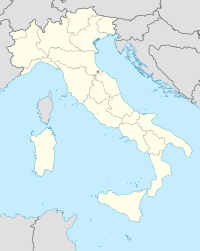Ferramonti di Tarsia internment camp
Location of Ferramonti di Tarsia |
The Ferramonti di Tarsia internment camp was an Italian civilian internment camp (campo di concentramento) in the province of Cosenza in southern Italy. It opened in June 1940 and liberated by British forces in September 1943.
history
1940-1943
After Italy entered the war in June 1940, the fascist regime set up the largest internment camp (campo di concentramento) for Jewish internees in a malaria-infested area, 35 km from Cosenza and in the municipality of Tarsia . Barracks were built on a total area of 16 hectares, in which an average of 900 inmates lived every day. In July 1940 there were only 100 Italian Jews from northern Italy in Ferramonti di Tarsia. However, the number of internees increased rapidly and peaked in August 1943 with internees in 2016, 75% of whom were of Jewish origin. The arrival was mostly in groups: z. B. 494 emigrants who survived the sinking of the refugee ship Pentcho (1940) and were initially interned in the Rhodes concentration camp (1942), 156 Jews coming from Ljubljana from German-occupied areas (1941), 194 Jews from a camp in Albania (1941) , several hundred internees from other camps (1942–1943). Non-Jewish internees were also transferred to Ferramonti: Greeks , Chinese , Yugoslavs and French from Corsica as well as Italian anti-fascists .
The camp management was generally relatively benevolent towards Jewish internees, who were also supported by the aid organization DELASEM (Delegazione per l'Assistenta degli Emigranti Ebrei) . Canteens, a library , an outpatient clinic and three synagogues were built in rooms specially made available for this purpose. The children received schooling. The local population also supported the camp inmates.
The war-related supply bottlenecks and the food rationing made the inmates increasingly difficult; in the winter of 1942/43 they had to starve.
| July 1940 | September 1940 | March 1941 | June 19422 | March 1943 | August 1943 | |
|---|---|---|---|---|---|---|
| Prisoners | 100 | 700 | 1,000 | 1,621 | 1,668 | 2.016 |
From 1943 until the end of the war
In September 1943 Ferramonti di Tarsia was liberated by the 8th British Army , which immediately opened a camp for displaced persons . On October 1, 1943, 1,854 people, three quarters of whom must have been Jews, were cared for in the camp. In April 1944 there were still 930 and at the end of the war 213 people in the camp. The official closure took place on September 6, 1945.
Web links
- Ferramonti Memorial Museum on memorial sites portal to places of remembrance in Europe
- The Ferramonti camp and the fascist internment at Memorial Forum
- Life in Ferramonti on Italy and the Holocaust Foundation
literature
- Carlo Spartaco Capogreco: Ferramonti. La vita e gli uomini del più grande campo d'internamento fascista (1940-1945) , Firenze 1987 (Giuntina)
- Carlo Spartaco Capogreco: I campi del duce. L'internamento civile nell'Italia fascista (1940-1943) , Torino 2004 (Einaudi)
- Francesco Folino: Ebrei destinazione Calabria (1940-1943) , Palermo 1988 (Sellerio)
- Mario Rende: Ferramonti di Tarsia. Voci da un campo di concentramento fascista 1940-1945 , Milano 2009 (Mursia)
- Klaus Voigt: Refuge on Revocation. Exile in Italy 1933-1945 , Vol. 2, Stuttgart 1993 (Klett-Cotta)
Individual evidence
- ^ Klaus Voigt: Refuge on Revocation - Exile in Italy 1933-1945 . Klett-Cotta 1993, p. 46
- ↑ A positive footnote in a dark chapter of history , NZZ, August 10, 2016
- ↑ Carlo Spartaco Capogreco: I Campi del duce . Giulio Einaudi 2004, ISBN 88-06-16781-2 , p. 244.
- ^ Klaus Voigt: Refuge on Revocation - Exile in Italy 1933-1945 . Klett-Cotta 1993, p. 434
Coordinates: 39 ° 35 ′ 0 ″ N , 16 ° 14 ′ 39 ″ E

